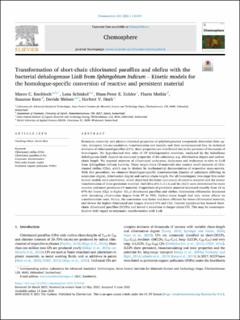Bitte benutzen Sie diese Kennung, um auf die Ressource zu verweisen:
https://doi.org/10.21256/zhaw-26804| Publikationstyp: | Beitrag in wissenschaftlicher Zeitschrift |
| Art der Begutachtung: | Peer review (Publikation) |
| Titel: | Transformation of short-chain chlorinated paraffins and olefins with the bacterial dehalogenase LinB from Sphingobium Indicum : Kinetic models for the homologue-specific conversion of reactive and persistent material |
| Autor/-in: | Knobloch, Marco C. Schinkel, Lena Kohler, Hans-Peter E. Mathis, Flurin Kern, Susanne Bleiner, Davide Heeb, Norbert V. |
| et. al: | No |
| DOI: | 10.1016/j.chemosphere.2021.131199 10.21256/zhaw-26804 |
| Erschienen in: | Chemosphere |
| Band(Heft): | 283 |
| Heft: | 131199 |
| Erscheinungsdatum: | 2021 |
| Verlag / Hrsg. Institution: | Elsevier |
| ISSN: | 0045-6535 1879-1298 |
| Sprache: | Englisch |
| Schlagwörter: | Chlorinated olefins (COs); Chlorinated paraffins (CPs); Enzymatic dechlorination; First-order kinetic model; Persistent organic pollutants (POPs); Alkenes; Environmental Monitoring; Kinetics; Paraffin; Hydrocarbons, Chlorinated; Sphingomonadaceae |
| Fachgebiet (DDC): | 660: Technische Chemie |
| Zusammenfassung: | Structure, reactivity and physico-chemical properties of polyhalogenated compounds determine their up-take, transport, bio-accumulation, transformation and toxicity and their environmental fate. In technical mixtures of chlorinated paraffins (CPs), these properties are distributed due to the presence of thousands of homologues. We hypothesized that roles of CP dehalogenation reactions, catalyzed by the haloalkane dehalogenase LinB, depend on structural properties of the substrates, e.g. chlorination degree and carbon-chain length. We exposed mixtures of chlorinated undecanes, dodecanes and tridecanes in-vitro to LinB from Sphingobium Indicum bacteria. These single-chain CP-materials also contain small amounts of chlorinated olefins (COs), which can be distinct by mathematical deconvolution of respective mass-spectra. With this procedure, we obtained homologue-specific transformation kinetics of substrates differing in saturation degree, chlorination degree and carbon chain-length. For all homologues, two-stage first-order kinetic models were established, which described the faster conversion of reactive material and the slower transformation of more persistent material. Half-lifes of 0.5-3.2 h and 56-162 h were determined for more reactive and more persistent CP-material. Proportions of persistent material increased steadily from 18 to 67% for lower (Cl6) to higher (Cl11) chlorinated paraffins and olefins. Conversion efficiencies decreased with increasing chlorination degree from 97 to 70%. Carbon-chain length had only minor effects on transformation rates. Hence, the conversion was faster and more efficient for lower-chlorinated material, and slower for higher-chlorinated and longer-chained CPs and COs. Current legislation has banned short-chain chlorinated paraffins (SCCPs) and forced a transition to longer-chain CPs. This may be counterproductive with regard to enzymatic transformation with LinB. |
| URI: | https://digitalcollection.zhaw.ch/handle/11475/26804 |
| Volltext Version: | Publizierte Version |
| Lizenz (gemäss Verlagsvertrag): | CC BY 4.0: Namensnennung 4.0 International |
| Departement: | Life Sciences und Facility Management |
| Organisationseinheit: | Institut für Chemie und Biotechnologie (ICBT) |
| Enthalten in den Sammlungen: | Publikationen Life Sciences und Facility Management |
Dateien zu dieser Ressource:
| Datei | Beschreibung | Größe | Format | |
|---|---|---|---|---|
| 2022_Knobloch-etal_Transformation-of-short-chain-chlorinated-paraffins-and-olefins_Chemosphere.pdf | 5.11 MB | Adobe PDF |  Öffnen/Anzeigen |
Zur Langanzeige
Knobloch, M. C., Schinkel, L., Kohler, H.-P. E., Mathis, F., Kern, S., Bleiner, D., & Heeb, N. V. (2021). Transformation of short-chain chlorinated paraffins and olefins with the bacterial dehalogenase LinB from Sphingobium Indicum : Kinetic models for the homologue-specific conversion of reactive and persistent material. Chemosphere, 283(131199). https://doi.org/10.1016/j.chemosphere.2021.131199
Knobloch, M.C. et al. (2021) ‘Transformation of short-chain chlorinated paraffins and olefins with the bacterial dehalogenase LinB from Sphingobium Indicum : Kinetic models for the homologue-specific conversion of reactive and persistent material’, Chemosphere, 283(131199). Available at: https://doi.org/10.1016/j.chemosphere.2021.131199.
M. C. Knobloch et al., “Transformation of short-chain chlorinated paraffins and olefins with the bacterial dehalogenase LinB from Sphingobium Indicum : Kinetic models for the homologue-specific conversion of reactive and persistent material,” Chemosphere, vol. 283, no. 131199, 2021, doi: 10.1016/j.chemosphere.2021.131199.
KNOBLOCH, Marco C., Lena SCHINKEL, Hans-Peter E. KOHLER, Flurin MATHIS, Susanne KERN, Davide BLEINER und Norbert V. HEEB, 2021. Transformation of short-chain chlorinated paraffins and olefins with the bacterial dehalogenase LinB from Sphingobium Indicum : Kinetic models for the homologue-specific conversion of reactive and persistent material. Chemosphere. 2021. Bd. 283, Nr. 131199. DOI 10.1016/j.chemosphere.2021.131199
Knobloch, Marco C., Lena Schinkel, Hans-Peter E. Kohler, Flurin Mathis, Susanne Kern, Davide Bleiner, and Norbert V. Heeb. 2021. “Transformation of Short-Chain Chlorinated Paraffins and Olefins with the Bacterial Dehalogenase LinB from Sphingobium Indicum : Kinetic Models for the Homologue-Specific Conversion of Reactive and Persistent Material.” Chemosphere 283 (131199). https://doi.org/10.1016/j.chemosphere.2021.131199.
Knobloch, Marco C., et al. “Transformation of Short-Chain Chlorinated Paraffins and Olefins with the Bacterial Dehalogenase LinB from Sphingobium Indicum : Kinetic Models for the Homologue-Specific Conversion of Reactive and Persistent Material.” Chemosphere, vol. 283, no. 131199, 2021, https://doi.org/10.1016/j.chemosphere.2021.131199.
Alle Ressourcen in diesem Repository sind urheberrechtlich geschützt, soweit nicht anderweitig angezeigt.